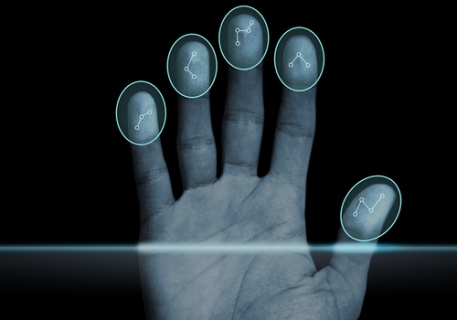
As mobile computing continues to grow, security concerns will lead to increased use of biometrics as mobile technology and mobile commerce continue to evolve, a new report out this month suggests.
In March 2013, the Biometrics Research Group estimated that U.S. consumers would use smartphones and tablet computers to make retail purchases of approximately $35 billion that year, compared with $20 billion in 2012.
“If that trend continues, we projected that the majority of online sales would be conducted on Apple rather than on Android mobile devices,” notes the research company’s more recent August 2014 report on mobile biometric authentication. “As a consequence, we expect that Apple could ultimately integrate fingerprint authentication into ‘Apple ID’ services to supplement the written password that provides access to all Apple cloud-based services, including iTunes purchases.”
Global mobile payment transactions will reach $250 billion this year and grow to $750 billion in annual transactions with more than 700 million users by 2020, according to the report. “We see biometrics as a transformative force that will speed mobile commerce, especially in North America, because the technology can offer a higher level of security, while providing an intuitive customer experience,” the research company said.
Visa/Apple rumors
Helping spur the company’s projections are recent rumors that dialogue is ongoing between Apple and Visa concerning a new mobile-commerce application. Sources briefed on the talks say Apple executives are discussing the launch of a mobile wallet as soon as this autumn to permit consumers to use their iPhones to purchase goods in brick-and-mortar retail stores, according to the report.
Such projections are consistent with those of PYMNTS.com, whose CEO, Karen Webster, earlier this month said she’s “followed enough breadcrumbs to believe that this time will be different,” referring to previous Apple-Near Field Communication (NFC) rumors that ultimately proved false. Apple’s latest iPhone, the 5s, includes the TouchID biometric access function, which a recent PYMNTS.com research report found lacking strong security. Apple likely will improve on the technology in its next phone.
It appears that the “big reveal” in early September will be an iPhone 6 that will support NFC in a secure element that Apple will control, Webster said. Phone owners then may use the token-based “wallet” with preregistered card data to pay for items in stores that accept NFC payments.
TouchID’s role
TouchID will authenticate the user, and participating issuers will pay Apple a fee when cards are first registered and then each time consumers use the phone to make a transaction, Webster predicted.
“This time horizon would allow Apple to build popularity and market share for the iWallet app on the lead-in to the holiday shopping season and the New Year,” the Biometrics Research Group report says.
Mobile payment transaction growth, combined with biometrics, will ensure increased speed of mobile commerce, especially in North America, because the technology can offer a higher level of security, while providing an intuitive customer experience, according to the report.
Biometric mobile projections
Biometrics Research Group projects more than 90 million smartphones with biometric technology will be shipped this year. Moreover, Goode Intelligence has forecast that by 2019, some 5.5 billion users of mobile and wearable biometric technology will exist globally. Goode Intelligence also projects the integration of fingerprint sensors in high-end smartphones and tablets will drive that growth, according to the research report.
Goode Intelligence projects that 619 million people will be using biometrics on mobile devices by the end of 2015. It also predicts that by 2017, there will be more than 990 million mobile devices with fingerprint sensors, the Biometrics Research Group report notes.
The report also highlights key drivers behind the adoption of mobile and wearable biometric authentication, including convenient authentication, replacing password and PINs, driving mobile payments, and securing enterprise mobility.
Enhanced security
Global Industry Analysts (GIA), the report notes, arguesd that the total market for biometrics for banking will exceed U.S. $8 billion by 2020. According to GIA, the market leading up to 2020 will be driven by an increased emphasis on protecting financial transactions from fraud and security breaches.
Andrews Research recently conducted a survey on behalf of the Deloitte Center for Financial Services that found that 72 percent of respondents would welcome the use of biometric identification, such as fingerprints or eye scans, to enable a mobile device, such as a tablet or smartphone, for financial transactions.
For banking security, more than half of survey respondents endorsed “preclearance” of a limited number of people who could receive a limited dollar amount of funds vis-a-vis mobile payment. Two-thirds of respondents also supported leveraging a mobile device’s GPS for real-time, location-based fraud sensing and prevention, according to the Biometrics Research Group report.
Biometric performance
Despite consumer concern over mobile-device security in the financial sector, the survey found that 63 percent of smartphone users had interacted with their bank through a mobile app.
Biometric performance quality traditionally has held back widespread use of the technology. Biometrics Research Group’s report notes improvements have been made, citing Kivox Mobile’s successful detection rate of more than 99.5 percent, with a false acceptance rate of less than 0.1 percent.
“On top of this, with the use of Agnitio’s proprietary patented anti-spoofing technology, Kivox Mobile detects up to 97 percent of replay attacks, as well as many other spoofing attacks such as cut and paste,” the report notes. “The protection is achieved as part of the verification attempt, without the need for any additional steps, such as ‘liveness’ detection.”